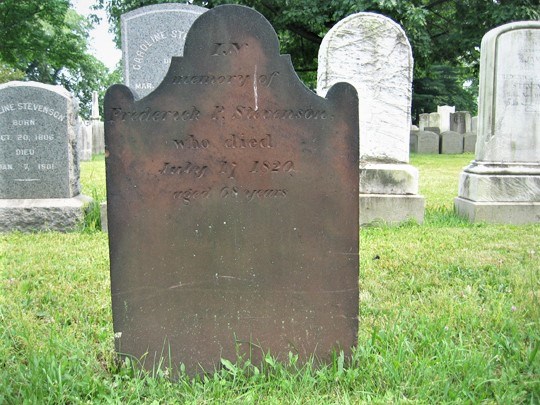Last updated: January 17, 2025
Article
New York Militia Soldier Who Fought at Battle of White Plains, buried at St. Paul's

National Park Service
New York Militia Soldier who Fought at Battle of White Plains, Buried at St. Paul’s
An estimated 200,000 men bore arms in support of American independence in the Revolutionary War, 1775-1783. Some of those soldiers served in the Continental army for several years and fought in engagements across several states of the new nation. Thousands contributed to the cause by serving with local units for much shorter durations. Frederick Phillipse Stevenson, who is buried in the historic cemetery at St. Paul’s Church National Historic Site, is one of those Americans who served with militia regiments, as required and needed, close to home.
Born in 1752, Stevenson was raised on his father Edward’s land in Throg’s Neck, Westchester County. Part of today’s New York City borough of the Bronx, the land is located about five miles from St. Paul’s. Edward Stevenson died in 1775, and left the land to his children. Frederick Stevenson married his second cousin Hannah, a common enough occurrence in the 18th century, given the area’s relatively small population.
As the American insurgency began in 1774-5, Stevenson was representative of young men in the area from families of means who supported the resistance movement and rose to ranks of responsibility in the emerging revolutionary forces, even though they had little prior military experience. In 1775, Stevenson was appointed as an ensign (the lowest of commissioned officers) in a local militia company. For reasons not entirely clear, in 1776 he was appointed a lieutenant in the 6th Regiment of Dutchess County Militia, which was commanded by Colonel Morris Graham and commonly known as Graham’s militia.
Graham’s regiment, and Lieutenant Stevenson, became embroiled in a major battle of the war because of the British invasion of lower New York in the summer of 1776. Crushing defeats in Brooklyn and Manhattan forced the American army to retreat north to Westchester County, and transfer military stores and provisions to White Plains, where Graham’s unit was responsible for guarding those vital supplies, a common militia obligation. The regiment in which Stevenson served was also part of the effort to construct defensive earth works along the hills that surrounded the north and west side of the village of White Plains, anticipating as assault by British and Hessian troops who had pursued the Americans. Colonel Rufus Putnam, General Washington’s engineering officer, supervised the construction of these works. In particular, Graham’s militia helped develop the defensive positions on Chatterton Hill, the far right flank of the American lines, overlooking the Bronx River.
Chatterton Hill was the scene of a powerful British assault on October 28, in perhaps the best known action of the Battle of White Plains. Graham’s militia, positioned behind stone walls, suffered a fierce cannonade in advance of an assault up the hill by crack troops of the British and Hessian armies. Faced with overwhelming numbers and firepower, and a pincer attack, the American forces hastily retreated. Over the next few days, elements of the scattered militia troops returned to Washington’s army.
After the fall of 1776, the military record of Frederick Stevenson’s service grows thin, although he clearly lived through the war and joined other Westchester County residents in building the young republic. Remaining active in the militia, he eventually achieved the rank of Colonel, and died July 17, 1820, at age 68. Colonel Stevenson was interred a few rows behind the church, and memorialized with a sandstone grave marker. His wife Hannah lived long enough to apply for a Revolutionary War widow’s pension in April 1855, receiving some payments. She died in 1858, age 87, in New York City, and is buried alongside her husband in the St. Paul’s cemetery.
